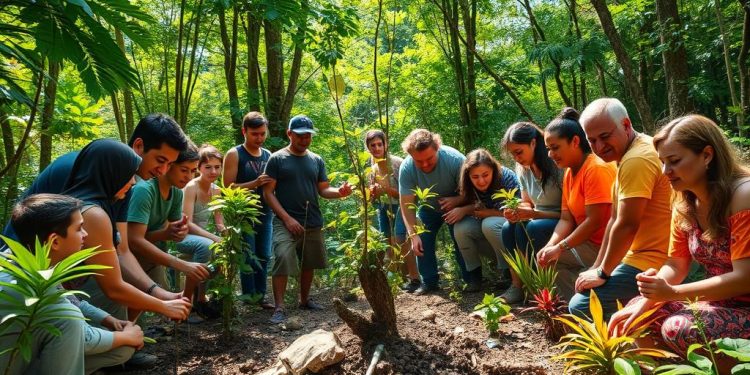Marine conservation is vital for the health of our oceans and the myriad species that call them home. With approximately 25% of all marine species depending on coral reefs for their habitat, protecting these delicate ecosystems is more crucial than ever. Not only do these vibrant underwater environments support a wide array of marine life, but they also serve as natural barriers against storms, contributing to coastal resilience.
However, our oceans face numerous threats, including climate change, pollution, and overfishing. Initiatives focusing on sustainable practices and habitat conservation are essential to safeguard marine biodiversity. Organizations are tirelessly working on innovative solutions, such as coral reef restoration and the creation of Marine Protected Areas (MPAs), which enhance local fisheries by allowing ecosystems to thrive.
Join the movement for ocean protection and help raise awareness about the pressing need for marine life conservation. Together, we can make a difference.
The Importance of Marine Conservation
Understanding the importance of marine conservation is essential for maintaining ocean health and promoting sustainable ecosystems. The oceans cover about 71% of the Earth’s surface and play a critical role in supporting a diverse range of marine species. They help regulate our climate while providing food and livelihoods for billions of people worldwide.
Understanding Our Oceans’ Role
The oceans contribute significantly to the global food supply, feeding approximately 50% of the world’s population. Despite their vastness, around 40% of marine ecosystems are reported to be harmed due to human activities such as overfishing, pollution, and climate change. Protecting ocean health is vital, as it ensures that marine biodiversity thrives, ultimately benefiting humanity.
Impact on Marine Biodiversity
Marine biodiversity encompasses a vast array of species, many of which remain undiscovered. It is estimated that hundreds of thousands of marine species have yet to be identified. Initiatives such as the Blue Parks aim to establish a global ocean refuge system, targeting the protection of at least 30% of ocean biodiversity. Establishing marine protected areas (MPAs) fosters recovery and restoration of marine ecosystems, thereby enhancing overall ocean health.
| Marine Conservation Statistics | Data |
|---|---|
| Percentage of Ocean Covered by MPAs | 8% |
| Number of Established MPAs Worldwide | 5,000+ |
| Distance of Galápagos Marine Reserve from South America | 1,000 km (600 miles) |
| Number of Species in Galápagos Waters | 3,000 |
| Year USS Monitor National Marine Sanctuary Established | 1975 |
| Significance of Georges Bank | Historic fishing grounds with declines in fish populations |
| Strict Fishing Rules Area in Great Barrier Reef | About 1/3 |
In summary, marine conservation efforts are crucial for protecting ocean health and biodiversity. The ongoing challenges for our oceans demand urgent action, emphasizing the importance of collective initiatives aimed at safeguarding these critical ecosystems.
Challenges Facing Our Oceans
The oceans are encountering a multitude of challenges that threaten their health and the creatures inhabiting them. Three significant issues—ocean pollution, climate change impacts, and overfishing—contribute to a precarious situation for marine ecosystems. Understanding these challenges is crucial for developing effective solutions to protect our seas.
Pollution and Its Effects
Ocean pollution remains a pressing concern, with over 12 million metric tons of plastic entering the oceans each year. This staggering amount leads to widespread habitat degradation and endangers marine life. The Great Pacific Garbage Patch, an expansive area of marine debris, highlights the severity of this issue. Furthermore, chemical runoff from agriculture and industrial sources introduces harmful substances into marine environments, impacting food safety and biodiversity. Mercury levels in ocean water are predicted to rise due to emissions from coal and oil-fired power plants, affecting seafood supply chains across all 50 states.
The Threat of Climate Change
Climate change impacts substantially compound the struggles facing our oceans. As temperatures rise, ocean pH levels are projected to drop from 8.1 to around 7.8 by the century’s end, a shift not witnessed in 14-17 million years. These alterations place tremendous pressure on marine ecosystems, leading to the proliferation of dead zones, which currently number over 500 and continue to grow. The overall balance of the marine ecosystem hangs in the balance, jeopardizing top predators and increasing the risk of lower-tier species overpopulation.
Overfishing and Unsustainable Practices
Overfishing represents another critical challenge, with bycatch resulting in the death of approximately 63 billion pounds of marine animals each year. The loss of top predators disrupts the delicate balance necessary for thriving marine habitats. The Magnuson-Stevens Fishery Conservation and Management Act serves as a tool aimed at sustaining fisheries in the United States, yet less than 2 percent of the ocean currently enjoys protection. If significant changes are not implemented, the potential wave of extinction facing marine life could rival the worst events since the dinosaur age.
Marine Conservation Initiatives
Several initiatives play a pivotal role in marine conservation. These efforts focus on coral reef preservation, the establishment of marine protected areas, and promoting sustainable fisheries practices. Each component plays a distinct and vital part in protecting our oceans and sustaining marine life.
Coral Reef Preservation Efforts
Coral reefs, often dubbed the “rainforests of the sea,” are essential ecosystems that support approximately 25% of all marine species. These underwater structures face numerous threats, including climate change, pollution, and overfishing. Dedicated programs aim to restore and protect coral through the cultivation of coral nurseries and the implementation of sustainable tourism practices. By fostering community involvement and awareness, efforts toward coral reef preservation gain strength, ensuring these vibrant ecosystems continue to thrive for future generations.
Protecting Marine Biodiversity Through Marine Protected Areas (MPAs)
Marine protected areas offer critical habitats where marine species can flourish without the pressure of fishing or human intervention. These zones promote biodiversity by safeguarding important breeding and feeding grounds. The U.S. has a wealth of marine protected areas that are vital for the management of fish stocks and the protection of vulnerable species, including dolphins, whales, and sea turtles. These initiatives often involve collaborations between federal agencies and international organizations aimed at combating illegal, unreported, and unregulated (IUU) fishing. Engaging local communities enhances the effectiveness of MPAs, fostering a sense of stewardship among those who rely on these resources.
Sustainable Fisheries Practices
The practice of sustainable fisheries balances ecological health with community needs. With the U.S. ranking as the third-largest wild seafood producer and fifth-largest exporter of fish products, responsible management of fish stocks is essential. Federal agencies continuously work together to ensure that fisheries operate within limits that preserve marine resources. Measures, such as introducing turtle excluder devices in shrimp harvesting, aim to minimize bycatch and protect endangered species. Moreover, annual certifications for shrimp-harvesting nations highlight the growing emphasis on conservation practices in the fishing industry.
| Aspect | Coral Reef Preservation | Marine Protected Areas | Sustainable Fisheries |
|---|---|---|---|
| Key Focus | Restoration and protection of coral systems | Safeguarding habitats for diverse marine life | Responsible management of fish stocks |
| Challenges | Climate change, pollution, overfishing | IUU fishing, community engagement | Bycatch, stock depletion |
| Community Role | Engagement in awareness and restoration efforts | Support for local stewardship | Participation in sustainable practices |
Community Involvement in Marine Conservation
Engaging in community involvement is essential for the success of marine conservation initiatives. By participating in local efforts, you can help support ocean protection while also fostering a sense of stewardship among community members. There are numerous ways you can contribute, each playing a critical role in preserving our marine ecosystems.
How You Can Contribute to Ocean Protection
Practicing responsible habits starts at home. Here are some effective actions you can take:
- Reduce waste by minimizing single-use plastics.
- Conserve water to help maintain healthy waterways.
- Advocate for sustainable seafood choices.
Community-led initiatives, like locally managed marine areas (LMMAs) and marine protected areas (MPAs), thrive on community involvement. In fact, in the Western Indian Ocean, local communities steward nearly half of the MPAs, covering over 11,000 km² of vital marine habitats.
Volunteering and Local Clean-Up Efforts
Participating in volunteer opportunities is a fantastic way to make a tangible impact. Local clean-up efforts, such as beach and underwater dives, help maintain healthy shorelines and provide education about ocean health to participants. Check with local conservation organizations for ongoing programs. Here’s a look at some of the benefits of volunteering:
| Benefits of Volunteering | Description |
|---|---|
| Community Engagement | Fosters teamwork and builds a strong community network. |
| Environmental Education | Increases awareness and knowledge about marine ecosystems. |
| Hands-on Experience | Provides practical knowledge and skills in conservation efforts. |
By participating in such initiatives, you contribute significantly to ocean protection efforts and help inspire others to engage in safeguarding our marine resources.
Conclusion
Marine conservation is vital for protecting ocean health and keeping the diverse life forms within it thriving. By understanding the marine conservation importance, you play a role in combating challenges such as pollution, climate change, and overfishing that jeopardize these ecosystems. Initiatives like Marine Protected Areas (MPAs) highlight how collective action can enhance the health of our oceans by promoting biodiversity and providing sustainable resources for communities reliant on fishing.
These protective measures are essential, as about 60% of global marine ecosystems have been degraded due to human activities. The urgency to establish more MPAs is a primary concern for conservationists, as current efforts fall short of the targets set by international biodiversity agreements. Large, remote MPAs and smaller, community-managed spaces can work in tandem to ensure long-term sustainability for marine life.
Ultimately, the road ahead demands a commitment to collaborative strategies in marine conservation. By engaging in local efforts and supporting policies aimed at protecting marine environments, you can contribute to a thriving ocean. Together, through collective action, we can ensure that future generations inherit a vibrant and healthy marine ecosystem.






